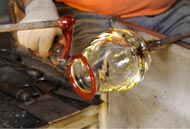
What is Industrial Sand?
Sand mined and processed in Wisconsin is an important ingredient in a wide variety of products. While much is used outside Wisconsin to help develop our nation’s energy resources and capture natural gas and oil from deep wells, a lot also is used to build roads, schools and more. Industrial sand is the primary ingredient in all types of glass, from the windows in your house and the windshield of your car to the food jars in your pantry, the drinking glasses in your kitchen, the fiberglass insulation that helps keep your house comfortable, and the screens on your TV, computer monitor and smart phone.
Foundries use industrial sand to make the molds and cores used to make metal castings found in your car as engine blocks, brake rotors and more. Industrial sand is used in the manufacture of ceramics such as the sink and tub in your bathroom, in the filtration of drinking water and on playgrounds and golf courses. The bottom line is that industrial sand has a significant role in much of what we do and how we live our lives.
Uses of industrial sand include:
- Glass Making
- Metal Casting
- Metal Production
- Chemical Production
- Construction
- Paint and Coatings
- Ceramics and Refractories
- Filtration and Water Production
- Oil and Gas Recovery
- Recreational Products
 Glassmaking: Silica sand is the primary component of all types of standard and specialty glass. It provides the essential SiO2 component of glass formulation and its chemical purity is the primary determinant of color, clarity and strength. Industrial sand is used to produce flat glass for building and automotive use, container glass for foods and beverages, and tableware. In its pulverized form, ground silica is required for production of fiberglass insulation and reinforcing glass fibers. Specialty glass applications include test tubes and other scientific tools, incandescent and fluorescent lamps, television and computer CRT monitors.
Glassmaking: Silica sand is the primary component of all types of standard and specialty glass. It provides the essential SiO2 component of glass formulation and its chemical purity is the primary determinant of color, clarity and strength. Industrial sand is used to produce flat glass for building and automotive use, container glass for foods and beverages, and tableware. In its pulverized form, ground silica is required for production of fiberglass insulation and reinforcing glass fibers. Specialty glass applications include test tubes and other scientific tools, incandescent and fluorescent lamps, television and computer CRT monitors.Metal Casting: Industrial sand is an essential part of the ferrous and non-ferrous foundry industry. Metal parts ranging from engine blocks to sink faucets are cast in a sand and clay mold to produce the external shape, and a resin bonded core that creates the desired internal shape. Silica’s high fusion point (1760°C) and low rate of thermal expansion produce stable cores and molds compatible with all pouring temperatures and alloy systems. Its chemical purity also helps prevent interaction with catalysts or curing rate of chemical binders. Following the casting process, core sand can be thermally or mechanically recycled to produce new cores or molds.
Metal Production: Industrial sand plays a critical role in the production of a wide variety of ferrous and non-ferrous metals. In metal production, silica sand operates as a flux to lower the melting point and viscosity of the slags to make them more reactive and efficient. Lump silica is used either alone or in conjunction with lime to achieve the desired base/acid ratio required for purification. These base metals can be further refined and modified with other ingredients to achieve specific properties such as high strength, corrosion resistance or electrical conductivity. Ferroalloys are essential to specialty steel production, and industrial sand is used by the steel and foundry industries for de-oxidation and grain refinement.
Chemical Production: Silicon-based chemicals are the foundation of thousands of everyday applications ranging from food processing to soap and dye production. In this case, SiO2 is reduced to silicon metal by coke in an arc furnace, to produce the Si precursor of other chemical processes. Industrial sand is the main component in chemicals such as sodium silicate, silicon tetrachloride and silicon gels. These chemicals are used in products like household and industrial cleaners, to manufacture fiber optics and to remove impurities from cooking oil and brewed beverages.
 Construction: Industrial sand is the primary structural component in a wide variety of building and construction products. Whole grain silica is put to use in flooring compounds, mortars, specialty cements, stucco, roofing shingles, skid resistant surfaces and asphalt mixtures to provide packing density and flexural strength without adversely affecting the chemical properties of the binding system. Ground silica performs as a functional extender to add durability and anti-corrosion and weathering properties in epoxy based compounds, sealants and caulks.
Construction: Industrial sand is the primary structural component in a wide variety of building and construction products. Whole grain silica is put to use in flooring compounds, mortars, specialty cements, stucco, roofing shingles, skid resistant surfaces and asphalt mixtures to provide packing density and flexural strength without adversely affecting the chemical properties of the binding system. Ground silica performs as a functional extender to add durability and anti-corrosion and weathering properties in epoxy based compounds, sealants and caulks.Paint and Coatings: Paint formulators select micron-sized industrial sands to improve the appearance and durability of architectural and industrial paint and coatings. High purity silica contributes critical performance properties such as brightness and reflectance, color consistency, and oil absorption. In architectural paints, silica fillers improve tint retention, durability, and resistance to dirt, mildew, cracking and weathering. Low oil absorption allows increased pigment loading for improved finish color. In marine and maintenance coatings, the durability of silica imparts excellent abrasion and corrosion resistance.
Ceramics & Refractories: Ground silica is an essential component of the glaze and body formulations of all types of ceramic products, including tableware, sanitary ware and floor and wall tile. In the ceramic body, silica is the skeletal structure upon which clays and flux components attach. The SiO2 contribution is used to modify thermal expansion, regulate drying and shrinkage, and improve structural integrity and appearance. Silica products are also used as the primary aggregate in both shape and monolithic type refractories to provide high temperature resistance to acidic attack in industrial furnaces.
 Filtration and Water Production: Industrial sand is used in the filtration of drinking water, the processing of wastewater and the production of water from wells. Uniform grain shapes and grain size distributions produce efficient filtration bed operation in removal of contaminants in both potable water and wastewater. Chemically inert, silica will not degrade or react when it comes in contact with acids, contaminants, volatile organics or solvents. Silica gravel is used as packing material in deep-water wells to increase yield from the aquifer by expanding the permeable zone around the well screen and preventing the infiltration of fine particles from the formation.
Filtration and Water Production: Industrial sand is used in the filtration of drinking water, the processing of wastewater and the production of water from wells. Uniform grain shapes and grain size distributions produce efficient filtration bed operation in removal of contaminants in both potable water and wastewater. Chemically inert, silica will not degrade or react when it comes in contact with acids, contaminants, volatile organics or solvents. Silica gravel is used as packing material in deep-water wells to increase yield from the aquifer by expanding the permeable zone around the well screen and preventing the infiltration of fine particles from the formation.Oil and Gas Recovery: Known commonly as proppant, or frac sand, industrial sand is pumped down holes in deep well applications to prop open rock fissures and increase the flow rate of natural gas or oil. In this specialized application round, whole grain deposits are used to maximize permeability and prevent formation cuttings from entering the well bore. Silica’s hardness and its overall structural integrity combine to deliver the required crush resistance of the high pressures present in wells up to 2,450 meters deep. Its chemical purity is required to resist chemical attack in corrosive environments.
 Recreational Products: Industrial sand even finds its way into sports and recreation. Silica sand is used for golf course bunkers and greens as well as the construction of natural or synthetic athletic fields. In golf and sports turf applications silica sand is the structural component of an inert, uncontaminated, growing media. Silica sand is also used to repair greens and to facilitate everyday maintenance like root aeration and fertilization. The natural grain shape and controlled particle size distribution of silica provides the required permeability and compaction properties for drainage, healthy plant growth and stability.
Recreational Products: Industrial sand even finds its way into sports and recreation. Silica sand is used for golf course bunkers and greens as well as the construction of natural or synthetic athletic fields. In golf and sports turf applications silica sand is the structural component of an inert, uncontaminated, growing media. Silica sand is also used to repair greens and to facilitate everyday maintenance like root aeration and fertilization. The natural grain shape and controlled particle size distribution of silica provides the required permeability and compaction properties for drainage, healthy plant growth and stability.(From the National Industrial Sand Association)
